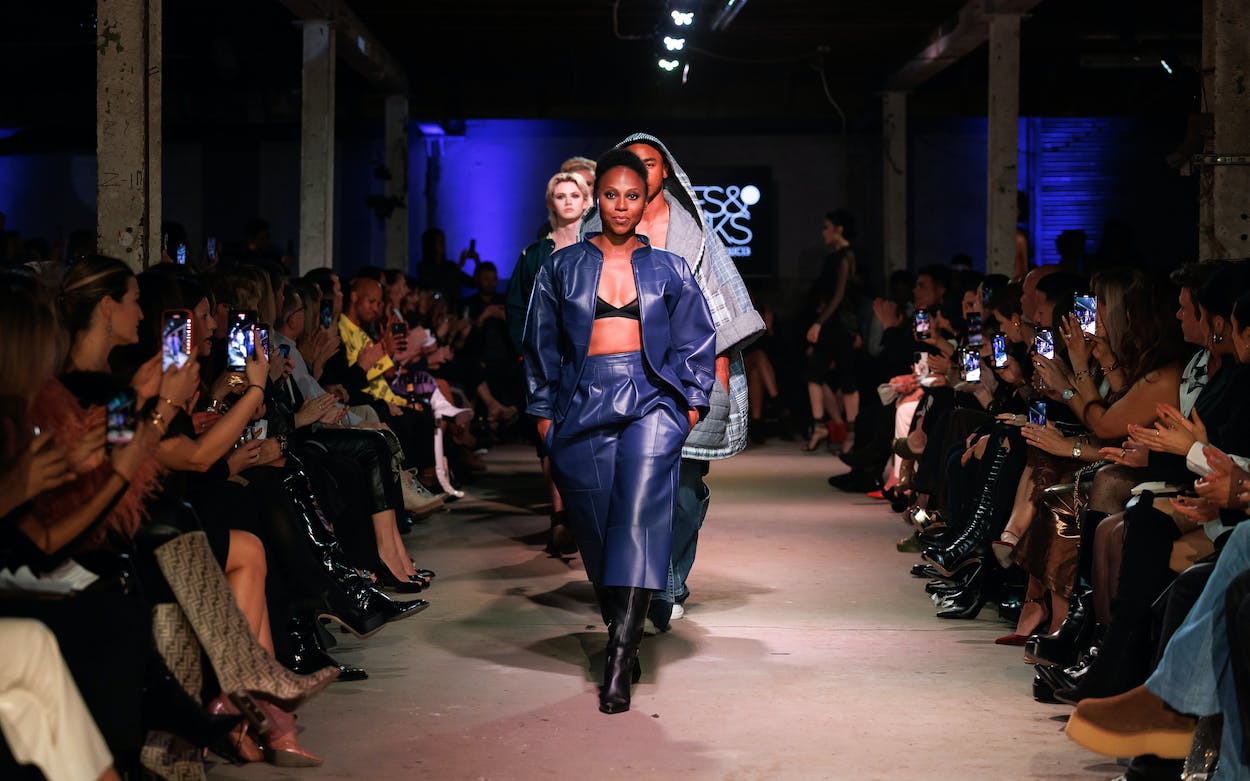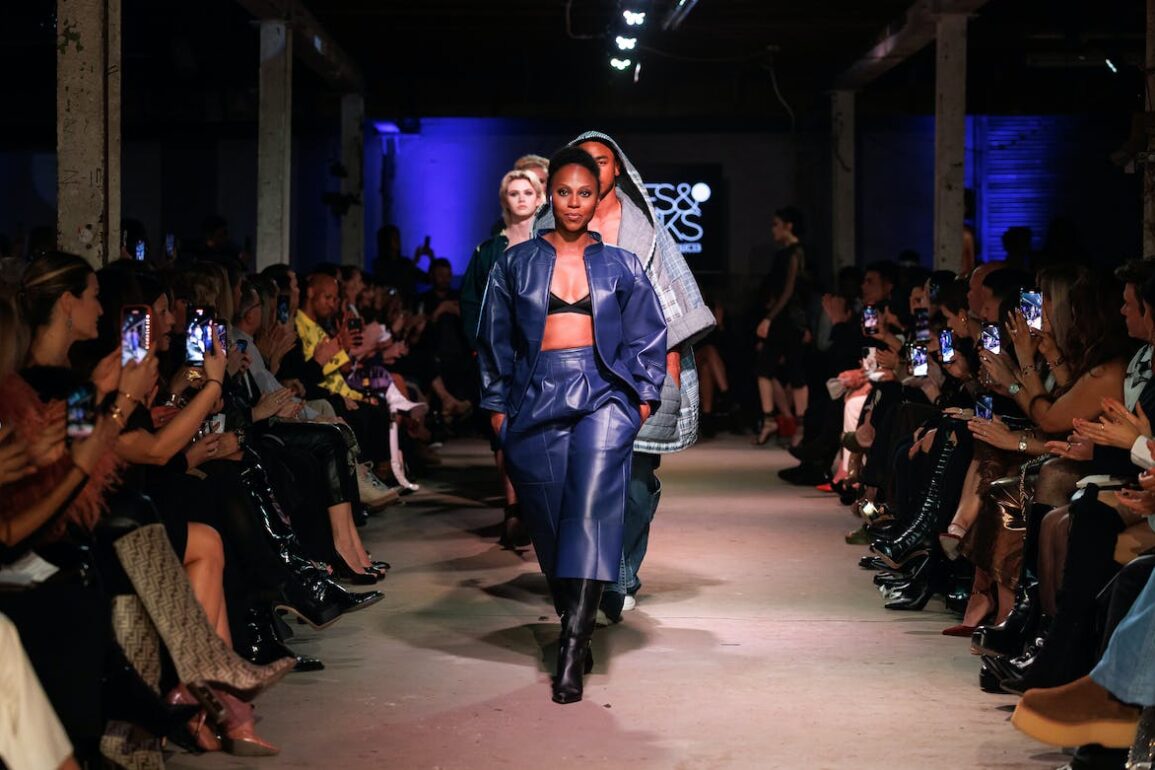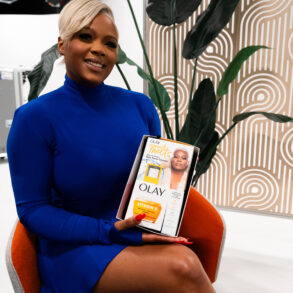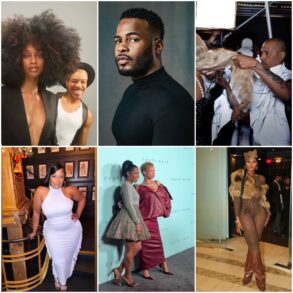For a Houston Nonprofit, One Woman’s Trash Is Another’s Couture Skirt
Magpies & Peacocks upcycles waylaid material, including old Super Bowl banners and Southwest seat cushions, and turns it into one-of-a-kind fashion.

Jay Marroquin/Magpies & Peacocks
The signature blue leather that cushions Southwest Airlines passengers’ backs and backsides during flights across the globe approached a new kind of runway on a recent Saturday night in Houston’s EaDo neighborhood. That same leather had been snipped, draped, and sewn up into a couture wrap skirt, a form-fitting vest, and patchwork culottes. A deejay played “Up, Up, and Away” by the 5th Dimension as chicly attired fashion show guests clapped appreciatively and models strutted by, each in a garment that used to be something else.
The Southwest designs, part of a new collection called “Take Flight,” were created for an annual fundraiser for Magpies & Peacocks, which bills itself as the U.S.’s “only 501(c)3 non-profit design house dedicated to the collection and sustainable reuse of post consumer clothing.” The organization was started in 2012 by London-born interior designer Sarah-Jayne Smith, who had become dismayed by the amount of clutter she found in her clients’ oversized Texas homes, with walk-in closets stuffed with clothes. “It was really clear to me, having come from Britain to the U.S., how culturally different we were in terms of our behaviors with stuff,” she says. “And nowhere was that more prevalent than the closet—and of course, how much space they had to store it.”
Magpies & Peacocks began collecting unwanted textiles, first through private donation, and as word spread, via corporate donations and fashion brands. Old clothes, along with banners and marketing collateral from conferences and corporate events—including eight miles of scrim from the 2017 Super Bowl when it was hosted in NRG Stadium, the largest material reclamation in the history of the game—made its way to Magpies & Peacocks. Many people never consider what happens to all the leftover banners, T-shirts, backdrops, drapes, and carpeting created for conferences and corporate events. The answer is that most of it just goes right to the dump. Smith sees waste as a resource, to be given a new life repurposed as high-end clothing and accessories available for purchase in the warehouse on Live Oak Street or online. Customers can shop vintage jeans punched up with metallic paint, or jackets and vests reworked from vegan leather and finished with raw hemlines or interesting trims.
Magpies & Peacocks has shown at London Fashion Week and been featured in Women’s Wear Daily and international fashion media, so its humble environs nestled in this nondescript warehouse district in Houston’s Second Ward are somewhat surprising. When you walk inside in the middle of June, as I did, the sweltering heat is only slightly mitigated by fans (there’s no air conditioning in here) and a catchy R&B playlist. Overhead, curious artwork assembled with wood planks, wires, fabric, and other items creates a feeling that anything can be turned into something else, again and again. Bolts of fabric and boxes create boundaries between a retail area and donation-based coffee/wine bar space in the front and a production area in the back, where a small team of women feed fabric into sewing machines in the late afternoon. Not many other brands let people peek behind the curtain of production, says Ahshia Berry, vice president and director of communications for Magpies & Peacocks. “And that’s the problem with the industry.”
In 2020, the organization worked with the city of Houston to launch a workforce development program, MAKR Collective, to employ survivors of trafficking and domestic violence, and people reentering society after serving time in prison. Employees make three to four times the minimum wage during their time here. Berry estimates they’ve trained about 45 people through the program, instructing them on sewing (2022 Miss Universe R’Bonney Gabriel serves as a lead sewing instructor) and customer service in the on-site coffee bar, but the emphasis is on giving them a year or two of solid employment experience to allow them to gain footing. “A lot of workforce development is having a conversation like this—you don’t realize until you work with traumatized people the basic things that get missed,” says Berry. “The skill training is important, but it’s what happens after. And we’re able to nest them for twelve to twenty-four months that eases them into normal job situations.”
In addition to MAKR Collective, growing community visibility and new partnerships for Magpies & Peacocks will lead the organization in 2024 to move all operations to a larger location one block away, to St. Charles Street, where the November fundraiser fashion show took place. (Berry’s most excited to let people know there will be air conditioning for the first time in a decade.) Like their old space, the one-hundred-year-old warehouse’s exposed brick walls, concrete floors, and loading bays are another reminder of how even spaces can be repurposed and reimagined.
Many people wouldn’t imagine that Houston would provide fertile ground for sustainable fashion. “That’s sort of the point,” says Smith, who enjoys upending people’s expectations of this oil town. “There are a lot of reasons why Houston is a good fit, mainly that it is affordable to do here. If you’re going to start something that hasn’t been done before, you need as few obstructions as possible.” The brand also capitalizes on Houston’s love of fashion, in a city where there is plenty of disposable income in some sectors for luxury goods, such as those found in Texas’s biggest mall, the Galleria. The Magpies & Peacocks team envisions the brand targeting similar consumers—this isn’t your average DIY upcycling; it’s elevated fashion for conscientious consumers.
As a port city, Houston is also a witness to one of fashion’s dirty little secrets: waste. This is where repackers operate, baling and selling waste textiles to developing countries. This was once a fairly lucrative business, but now many brands—particularly luxury brands—would rather incinerate or shred their excess inventory. In Ghana, they used to call textile waste “dead white man’s clothing,” Smith says. “The assumption was that nobody would be giving up these textiles unless someone was dead, because they couldn’t imagine an industry that created so much waste.” But now, overproduction of poor quality so-called fast fashion textiles means “dead white man’s clothing” is shipped back and forth across the globe only to go to the landfill or pile up on beaches in Africa and elsewhere. Smith says $100 billion in clothing is trashed annually; 75 percent of everything you’ve ever worn goes to the landfill.
The fashion industry has had a harrowing track record on human rights over the past decade. In 2013, more than 1,100 people working in an apparel factory in Dhaka, Bangladesh, were killed in a building collapse, after years of fires and other industrial accidents. Several U.S. clothing labels were found among the rubble, a grim example of the poor working conditions and safety in the chief clothing exporter for the U.S. and Europe. In 2021, an international accord holding the garment and textile industry to higher safety standards went into effect, but the workforce of mostly women still toils for long hours and little pay. Just this month, the Bangladesh government raised the minimum wage to $113 per month (from $75), which many protest are still poverty wages.
“It’s become one of the largest polluters on the planet, one of the most oppressive industries, and also, because it’s so massive, it affects one in six people globally,” says Smith. “We’ve ended up with an industry that is truly despicable, and that’s even before you get into the pesticides, and the agricultural workplaces that feed that industry, and the water sources that it takes to produce. Pretty much every stone you turn is going to show you a horror story.”
There are signs that younger generations are interested in righting these wrongs. Millennial and Gen Z shoppers are showing more interest in sustainable clothing lines, upcycled clothing, and thrifting. Brands are looking to sponsor events and collaborate with vendors that have sustainability as a core value. And in a Houston warehouse filled with some big spenders on a recent Saturday night, change was already in the air and taking flight.
- More About:
- Style & Design
- Fashion
- Houston
This post was originally published on this site be sure to check out more of their content.









